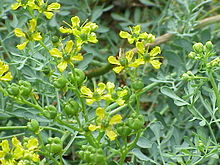Rue
|
Ruta graveolens Common rue |
|
|---|---|
 |
|
| Common rue in flower | |
| Scientific classification | |
| Kingdom: | Plantae |
| (unranked): | Angiosperms |
| (unranked): | Eudicots |
| (unranked): | Rosids |
| Order: | Sapindales |
| Family: | Rutaceae |
| Genus: | Ruta |
| Species: | R. graveolens |
| Binomial name | |
|
Ruta graveolens L. |
|
 |
|
Ruta graveolens, commonly known as rue, common rue or herb-of-grace, is a species of Ruta grown as an ornamental plant and as an herb. It is native to the Balkan Peninsula. It is now grown throughout the world in gardens, especially for its bluish leaves, and sometimes for its tolerance of hot and dry soil conditions. It is also cultivated as a medicinal herb, as a condiment, and to a lesser extent as an insect repellent.
The Tacuinum Sanitatis, a medieval handbook on wellness, lists these properties of rue:
The refined oil of rue is an emmenagogue and was cited by the Roman historian Pliny the Elder and the gynecologist Soranus as a potent abortifacient (inducing abortion).
Rue does have a culinary use if used sparingly, but it is bitter and gastric discomfort may be experienced by some individuals. Although used more extensively in former times, it is not a herb that is typically found in modern cuisine, and is today largely unknown to the general public and most chefs, and unavailable in grocery stores. It is a component of berbere, the characteristic Ethiopian spice mixture, and as such is encountered in Ethiopian cuisine.
Rue is also grown as an ornamental plant, both as a low hedge and so the leaves can be used in nosegays.
Most cats dislike the smell of it, and it can, therefore, be used as a deterrent to them (see also Plectranthus caninus).
Caterpillars of some subspecies of the butterfly Papilio machaon feed on rue, as well as other plants. The caterpillars of Papilio xuthus also feed readily on it.
In South India, rue is recommended for home gardens to repel snakes (however the effectiveness is unknown).
...
Wikipedia
